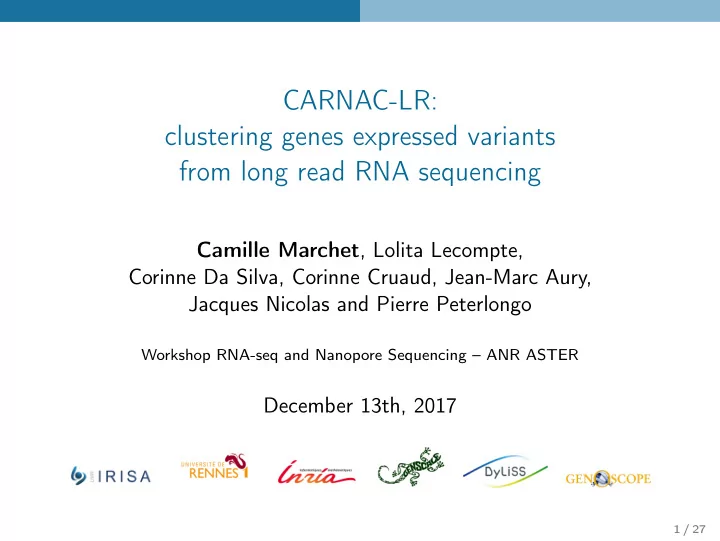

CARNAC-LR: clustering genes expressed variants from long read RNA sequencing Camille Marchet , Lolita Lecompte, Corinne Da Silva, Corinne Cruaud, Jean-Marc Aury, Jacques Nicolas and Pierre Peterlongo Workshop RNA-seq and Nanopore Sequencing – ANR ASTER December 13th, 2017 1 / 27
RNA-seq and long read sequencing Direct access to the different isoform structures and full-length molecules Avoid assembly / transcript reconstruction by mapping Quantification with ONT long reads [Oikonomopoulos et al. 2016] Annotated variants and novel variants discovery with long reads [Hoang et al. 2017, Abdhel-Ghany et al. 2016, Wang et al. 2016,...] 2 / 27
To map or not to map? Mapping of reads on reference genome (GMAP [Wu et al. 2005]) Or transcriptome (recently Graphmap [Sovic et al. 2015]) What if no reference ? 3 / 27
A need that starts to be expressed in the literature ToFu: cluster of reads by gene and isoforms detection[Gordon et al. Plos One 2015] Describe alternative variants: [Liu et al. Molecular ecology Resources 2017] Both dedicated to PacBio, need sequences of high accuracy Our goals More generic approach Make the best of the full data set, no prior filter/treatment 4 / 27
Expected behavior of our clustering 5 / 27
Detect all variants for each gene de novo Problem specificity Alternative variants in data Gene families Errors in reads Heterogeneous sizes distributions of clusters 6 / 27
A clustering problem: graph we work on 7 / 27
A clustering problem: clusters as genes 8 / 27
A clustering problem: graph in practice 9 / 27
A clustering problem: community detection 10 / 27
Detect all variants for each gene de novo Community detection Deal with the indel specificity: detect overlaps between erroneous reads (Minimap[Li 2016], GraphMap[Sovic et al. 2015], BLASR[Chaisson et al. 2012]...) Start for clustering of variants : graph of similarity of reads 11 / 27
Measure of connectivity in the graph We rely on the clustering coefficient ( ClCo ) [Watts and Strogatz 1998] 12 / 27
Clustering problem Prop.1: A community is a connected component having a clustering coefficient above or equal to a fixed cutoff θ . Prop.2: Communities are disjoined sets. 13 / 27
Clustering problem Prop.3: An optimal clustering in k communities is a minimal k -cut of the graph min k -cut NP hard for k ≥ 3 [Dahlhaus et al. 1994]) 14 / 27
Difficulties arising from this problem We don’t know the number of community in advance, k -cut NP-hard for k ≥ 3 [ ? ] The cutoff θ is not known either Potentially many θ values to test 15 / 27
Implementation: choose theta interval The cutoff θ is not known: test different values Do not compute all possible θ for all connected components Adaptive values for each connected component Key for scaling 16 / 27
Implementation: find k 17 / 27
Implementation: find k 18 / 27
Final communities Keep the partition associated to the minimal cut 19 / 27
Pipeline github.com/kamimrcht/CARNAC 20 / 27
How to validate ? Data: mouse transcriptome 1D Nanopore reads transcriptome NB: mapping has its own limitations 21 / 27
Comparison to other community detection approaches Comparison to classic approaches: hierarchical, modularity based, CPM CARNAC-LR pros Best precision Best trade-off between precision and recall Best similarity to ground truth clusters (Jaccard Index) No need of parameters Well-tailored clustering for transcriptomic long reads 22 / 27
Validation real size data set ∼ 1M reads Recall and precision not much impacted by expression levels Minimap + CARNAC-LR: 3 hours using 10 threads / Mapping approach: ∼ 15 days 23 / 27
Proxy to genes’ expression variant expression estimated with clustering 600 density 300 400 100 10 R = 0.8002 200 0 0 100 200 300 gene expression estimated with mapping Straightforward use of our method 24 / 27
A visual example of CARNAC’s output 112 reads from a cluster output by CARNAC (purple) All reads map to the same locus: gene Pip5k1c (chr 10) 8 reads present in the data missing in the cluster (black) 25 / 27
Future work Correct by clusters and find isoforms within clusters 26 / 27
Conclusion Take-home messages Accurate tool that outputs clusters of transcripts by gene Generic, first tool to perform on ONT For model and non model species Availability: github.com/kamimrcht/CARNAC Preprint Perspectives Scale to meta-transcriptomics Acknowledgments Dyliss, GenScale teams and Genouest platform Genoscope and ANR ASTER 27 / 27
Recommend
More recommend